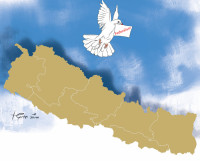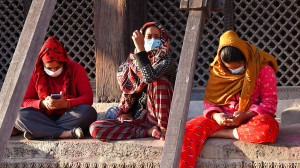Opinion
LDC graduation a milestone, not a goal
Acknowledging the special socio-economic and developmental needs of certain countries, the Committee for Development Policy (CDP), a subsidiary advisory body of the United Nations Economic and Social Council (ECOSOC),
Mina Aryal
Acknowledging the special socio-economic and developmental needs of certain countries, the Committee for Development Policy (CDP), a subsidiary advisory body of the United Nations Economic and Social Council (ECOSOC), categorised them as least developed countries (LDCs) in 1971. Judging by the level of advancement in specified criteria, an LDC can be graduated to a developing country.
Though considerable endeavours on substance and process are taking place at the national and global level, including the International Support Mechanisms (ISMs) to support the graduation of LDCs, there is a need of substantial breakthrough in the current systems, mechanisms and initiatives to achieve sustainable inclusive development. Framing the national development plans and sectorial road maps strategically by taking graduation as momentum and not a winning post is considerably important in this respect.
Developmental issues
Being categorised as LDCs is a recognition of the specific challenges that are hampering countries from realising their structural transformation initiatives. The major challenges in this respect are: pervasive poverty, fragile productive capacity, narrow export base, and financial, technical, institutional and human resource deficiencies, all of which have hindered meeting the graduation criteria and achieving structural transformation in the LDCs.
The LDC group at the WTO is deeply engaged under its special and differential treatment (S&DT) scheme, with an agenda that is supportive in achieving structural transformation and diversification in the relevant economies. Despite the continued efforts of national governments and the international community, only four LDCs; Cape Verde, Samoa, Botswana and Maldives have graduated thus far.
The LDCs are taken as the battle ground on which the 2030 agenda will be won or lost. However, current economic outlook reveals that economic growth in the LDCs decreased sharply and reached 3.6 percent in 2015, which contrasts with the 7 percent annual growth target of the Istanbul Plan of Action (IPoA). Similarly, their contribution to the world export market is less than 1 percent, against the set target of IPoA on doubling the LDCs export and the reiteration of the same by the 2030 Agenda for Sustainable Development Goals (SDG 17.11). Shared vision, shared responsibility and shared action are substantially important to achieve global commitments including IPoA and SDG since we are living in an interconnected and interdependent global village.
International support mechanisms (ISMs) are available across the field of development, finance, technology, technical assistance and trade including duty free quota free (DFQF) market access, aid for trade (AfT) and enhanced integrated framework (EIF) initiatives to support structural transformation, enhance productive capacity and strengthen supply-side capacity, among others.
The three criteria fixed by the CDP in 2015 needed for graduation are: (i) per capita gross national income (GNI) of $1,242 or more; (ii) achieving a score of 66 or more under the Human Assets Index (HAI) which includes health, nutrition and education index; (iii) a country’s vulnerability to external economic and environmental shocks (EVI), which includes eight indicators including natural shocks and trade shocks; an LDC with score of 32 or less is considered eligible for graduation in this indicator. In 2015, Nepal’s GNI was recorded to be $659, quite below the threshold, HAI was 68.7 and EVI was 26.8. However, the impact of the 2015 earthquake and aftershocks, followed by supply obstruction, on the HAI and EVI is yet to be published. The 2018 review of CDP will mirror the updated facts and figures. To graduate, a country must meet two criteria out of three.
Growing up well
The approach paper of the 13th periodic plan issued by the National Planning Commission, forecasts that the country will graduate from LDC to a developing country by 2022 based on HAI and EVI.
If Nepal graduates based on two criteria viz HAI and EVI, income factor must also be addressed as it is pivotal among the three criteria. Although there is a grace period of up to three years after graduation, there is less possibility to recover the income gap. In this backdrop, Nepal should seriously analyse the sustainability dynamics of the graduation.
In our context, the graduation should be dealt by adopting a five pronged strategy. Firstly, intellectual and political discourse should take place to analyse the benign and the malign; the sustainability dynamics of when Nepal is graduating without maintaining income indicators (GNI) should also be analysed. Serious analytical discourse is highly imperative on macroeconomic indicators such as foreign trade performance which is continuously ballooning each year, making the export-import ratio 1:13; decreased contribution of the manufacturing sector to the GDP which is about 5 percent; remittance dependent economy accounting for almost 30 percent of the GDP, and almost 90 percent of the remit amount that is expensed in consumable goods instead of for capital formation; and low budgetary absorptive capacity of bureaucratic machinery. Against this backdrop, Nepal may decide not to graduate unless and until it maintains the income index.
Secondly, graduation should be taken as a process, a means and a momentum to scale up economic prosperity and long-term socio-economic sustainable development—and not the end of the race. Thus, development endeavours must also assume a systemic approach on smooth transition and post-graduation strategy.
Thirdly, political and intellectual discourse must be undertaken to choose the ‘right model of development’ by contextualising our state restructuring, and also international political, economic and trade dynamics, which include advancement in ICT, automation, global/regional value chains and e-commerce. Materialisation of the priority areas in the changing dynamics of Nepal, as outlined by the newly appointed Vice Chairman of the National Planning Commission, Swarnim Wagle, such as restructuring of the National Planning Commission and the Ministries, formulation of an integrated national development plan, financial sector reform, a big push to infrastructure development, and cooperative federalism could complement such discourse. The agreed development trajectory should be maintained far beyond graduation from an LDC.
Fourth, there is a requirement of an the institutional strengthening, as an institution matters significantly to enhance good governance, rule of law, better coordination at the global, regional and national level, and leveraging and managing the resources for sustainable impact, among others. Finally, rural transformation by addressing chronic underinvestment, diversifying rural economies by reducing their reliance on agriculture, upgrading farming technology and practices, enhancing research and development, globalisation of agri-food systems and improved access to finance for smallholder farmers and rural SMEs are critical in this regard.
To conclude, for the materialisation of the five pronged-strategy proposed above, leveraging and effective management of financial, technical and human resources, and enhancing physical and digital connectivity at the national and regional level are equally important. Similarly, the international community should have shared vision, responsibility and action to translate global commitments into action and result.
Aryal is the Deputy Permanent Representative (Commerce), Permanent Mission/Embassy of Nepal to Geneva, Switzerland




 9.12°C Kathmandu
9.12°C Kathmandu
.jpg&w=200&height=120)







%20(1).jpg&w=300&height=200)

